|
S-MATCH© |
The Balanced Universal ATU |
(PA0FRI's "S-MATCH ATU" published in RSGB's RadCom March 2003 and VERON's ELECTRON November 2003)
![]() 06-Apr-2019
06-Apr-2019

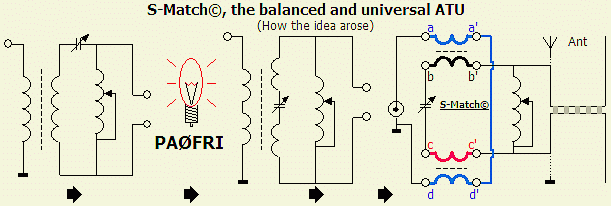
How the idea arose.
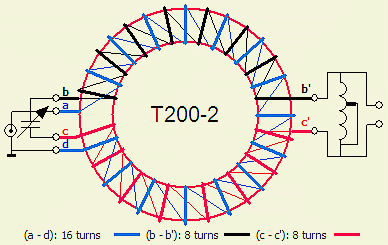
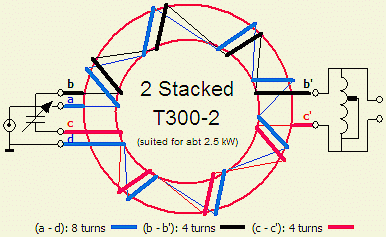
Micro Metals/Amidon toroids suitable for this ATU.
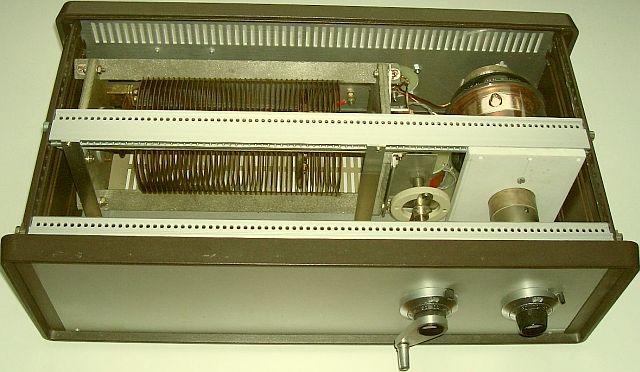
A 1500 W S-Match.
|
A model of the third variation |
Home brewed with cleaned and painted components from the junk box. |
|
|
With this system it was possible to match for SWR = 1 on all 9 HF bands with respective a 2 × 17 dipole and a W3DZZ. Both antennas were feed with approximately 10 m ladder line. Undoubtedly a G5RV can be matched for SWR = 1. |
S-MATCH©
.
Several possibilities of the S Match design.
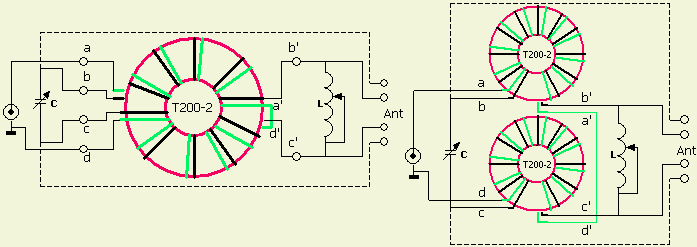
After an extensive research and experimenting I achieved the design shown in the above drawings of the Balanced Universal ATU System. To make it distinctive from other types of ATU's, I call my design S-Match©. The system is intended to accommodate balanced antenna systems transmitting on a very wide frequency spectrum, ranging from 160 m band up to 10 m band. Likewise, it is able to take proper care of impedances and associated reactances ranging from less than 20 ? and up to 3000 ?. Built with the proper components, it is able to transfer loads of more than 1000 Watts. This balanced antenna-tuning unit has only three components: a capacitor, a roller inductor and a balun or RF transformer. The input circuits are isolated from the output circuits, resulting in a system, which is suitable also for single-wire antennas and coax fed antennas.

The efficiency of mechanical and electrical a well-built S-Match is equivalent to other ATU's in this («fig) table. See my Test Symmetrical ATU's.
|
|
|
|
|
|
In the design of one of my ATU’s, the balun using T200A-2 toroid is mounted between two PCB disks and located in between the 50 µH roller-inductor and the 12 – 1200 pF vacuum capacitor.
An antenna like my present antenna system is matched using only 200 pF on all nine HF bands, still my S-Match is built with a 1200 pF vacuum capacitor. My ATU was able to match easily the antennas of a couple of friends. In one case it was barely adequate to match another friend's 4 × 40m loop antenna on 160 m. I had to add an extra switchable 1200 pF capacitor in parallel with the roller inductor to handle any impedance. (see further below)
CAPACITANCE

With some antenna systems a better efficiency may be achieved if the antenna is connected to the capacitor as shown in the drawing by the dotted line. It is also possible to use two separate toroids. I didn’t notice any difference between an ATU with two cores and an ATU built with a single toroid.
TRANSFORMER
|
|
|
Transformers made with Amidon toroids. The T200A-2 toroid is a nearly exact substitute of two T200-2 units sandwiched together.
|
ATTENTION: Do not twist the black and green wire! The inductance of the turns is a part of the resonant circuit with the roller-inductor and the capacitor. |
Wires are twisted for more thickness. |
|
|
|
The rule-of-thumb for the windings is: ATU for 10 – 160 m: (a-b) = (c-e) in series with (f-d) ≈ 3 µH ATU for 10 – 30 m: (a-b) = (c-e) in series with (f-d) ≤ 3 µH ATU for 30 – 160 m: (a-b) = (c-e) in series with (f-d) ≥ 3 µH |
|
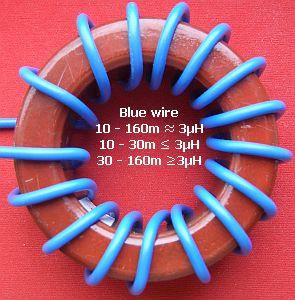

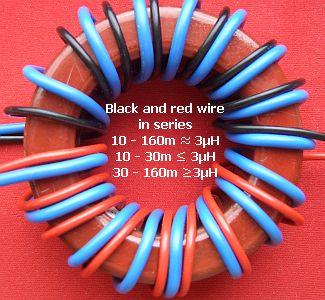
The transformer contributes a lot to the final result, which is my conclusion after I tested many types of windings. A couple of ham friends successfully tested a number of my own ideas for a suitable HF transformer/balun. The above chosen type of transformation ensures that input and output connections are galvanic isolated. The experiments show that an inductance of about 3 µH is a good compromise for all HF bands. Sometimes the minimum inductance (coil + balun) is too large for some 10-30 m antenna systems. Subsequently, extending or shortening the feeding line was necessary to change the antenna system impedance to cope with the tuner, or build a separate ATU with fewer turns e.g. less than 3 µH on the toroid.
The transformer/balun is part of the tuning system. Most ferrite toroids are not suitable for high power or high RF current while the indicated Amidon iron powder core is.
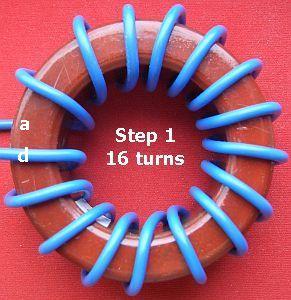
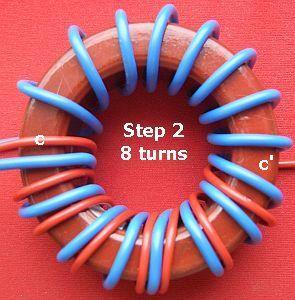
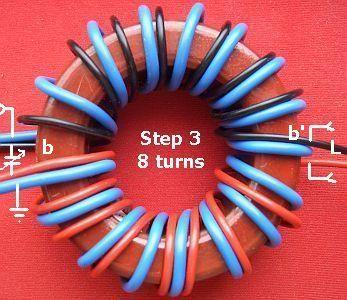
The sequence of the windings. Left side: blue = input, black & red = capacitor. Right side: black & red = inductor.

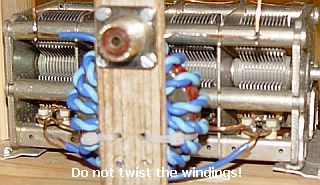
The windings should provide high-voltage insulation by using Teflon covered wire. Another option would be to use RG58 coax cable with the outer isolation and screen stripped off. Do not twist the wires of the primary windings with the wires of the secondary windings. In the picture (see fig») the light blue with the blue wires.
"PIG NOSE" BALUN
RZ3AE's S-Match ATU
|
|
|
|
RZ3AE has sent me an email with attachment: "Your idea for a balanced tuner allows for a very interesting design. A translated part of his Russian article, he wrote:" With the unconventional design and the use of special components a small symmetrical tuner may be created.
|
RZ3AE used two ferrite tubes as balun. |
The balun in the original design was replaced with two stacked ferrite tubes of high permeability and the roller inductor by a T200-2 toroidal coil with 15 taps. Taps 1 through 3 one turn, 4 to 6 two turns, 7 and 8 three turns, and 9 to 15 four turns evenly distributed over the rest of the toroid.
The balun is suitable for an output less than or equal to 100 W and the wire is insulated with Teflon.
The various amateur bands may be adjusted to 600 Ohm with VSWR <1.1 and 1000 ohms with SWR to 1.3. For impedance less than 50 ohms, the antenna must be connected to the variable capacitor;
See his internet publication: RZ3AE S-tuner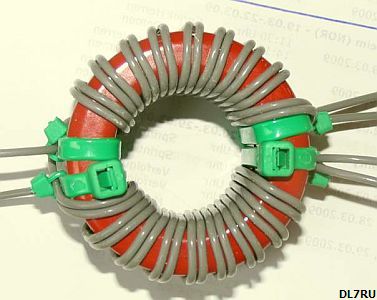
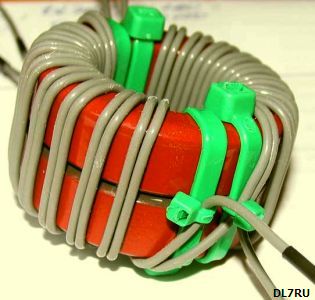
DL7RU has personally experienced that it is not easy to wind Teflon covered wire on a toroid and keep them firmly in place. DL7RU: I have now found a method to do the job much easier. First of all, I start with a couple of tight pulled cable ties on each side of the toroid. Under these ties I put smaller and thinner ones. This fixes the beginning and end of the windings so that it is easier to settle the wires.
DL7RU hat selbst erfahren und wie er es auch auf diese Web-Site gesehen hat: das Bewickeln eines Ringkernes mit Teflonlitze zum Bau eines S-Match ist nicht ganz einfach. Er schreibt:
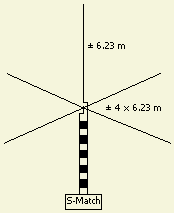 Ich habe nun eine Methode gefunden, mit deren Hilfe man größere Ringkerne wesentlich einfacher bewickeln kann. Zunächst bringe ich größere Kabelbinder für den Wickelanfang und das Wickelende am Ringkern an und ziehe sie gut fest. Unter diese Kabelbinder stecke ich dann dünnere Kabelbinder mit denen ich die Wickeldrähte festlege (siehe Bilder). So brauche ich den Wickelanfang nicht mehr im Schraubstock festzuklemmen um den Kern stramm bewickeln zu können und der Draht liegt schön in der Wickelrichtung.
Ich habe nun eine Methode gefunden, mit deren Hilfe man größere Ringkerne wesentlich einfacher bewickeln kann. Zunächst bringe ich größere Kabelbinder für den Wickelanfang und das Wickelende am Ringkern an und ziehe sie gut fest. Unter diese Kabelbinder stecke ich dann dünnere Kabelbinder mit denen ich die Wickeldrähte festlege (siehe Bilder). So brauche ich den Wickelanfang nicht mehr im Schraubstock festzuklemmen um den Kern stramm bewickeln zu können und der Draht liegt schön in der Wickelrichtung.
Auf den HF-Übertrager habe ich ein paar mehr Windungen aufgebracht weil ich den Tuner nur für das 40, 80, 160 m Band verwenden will. Der Übertrager auf dem Bild hat ~8 µH für die Einkoppelwicklung und ~2 × 4 µH für die Auskoppelseite. Ich denke das sollte reichen für das 160 m Band. Für die höheren Bänder habe ich schon ein S-Match gebaut (10 - 30 m Band) und bin sehr zufrieden mit diesem Konzept. Ich betreibe (fig») damit eine Groundplane Antenne die ich über eine Wireman-Hühnerleiter (CQ 553) speise. Das funktioniert ganz wunderbar. Die Antenne ist 6.23 m lang (5/8 für 28.5 MHz) und die vier Radials ebenso.

With some antenna systems a better efficiency can be obtained when the antenna is connected as shown by the dotted line. It is also possible to use two separate toroids and I have not noticed any difference between an ATU with two cores or with a single core.
IMBALANCE, WIRING


If any unbalance occurs, try switching to the other connection or interchange the connections to the roller inductor.
My experience shows that some unbalance in an ATU occurs due to the construction and the location of the components. For example, a variable capacitor has frame and movable plates, which are not in any balance with respect to the chassis or system ground. The basic mechanical construction of roller coils is also not symmetrical.
Always begin with matching the system for SWR = 1, to obtain maximum balance. Unbalance is usually the result of inaccurate tuning. With the usual baluns it may look as if the feeding line is symmetrical, but the centre taps of the bifilar and trifilar wound toroids force the balance with respect to "ground" or chassis (fig.a).
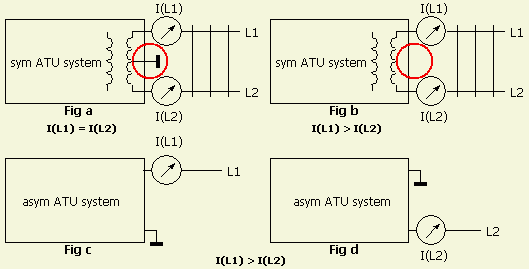
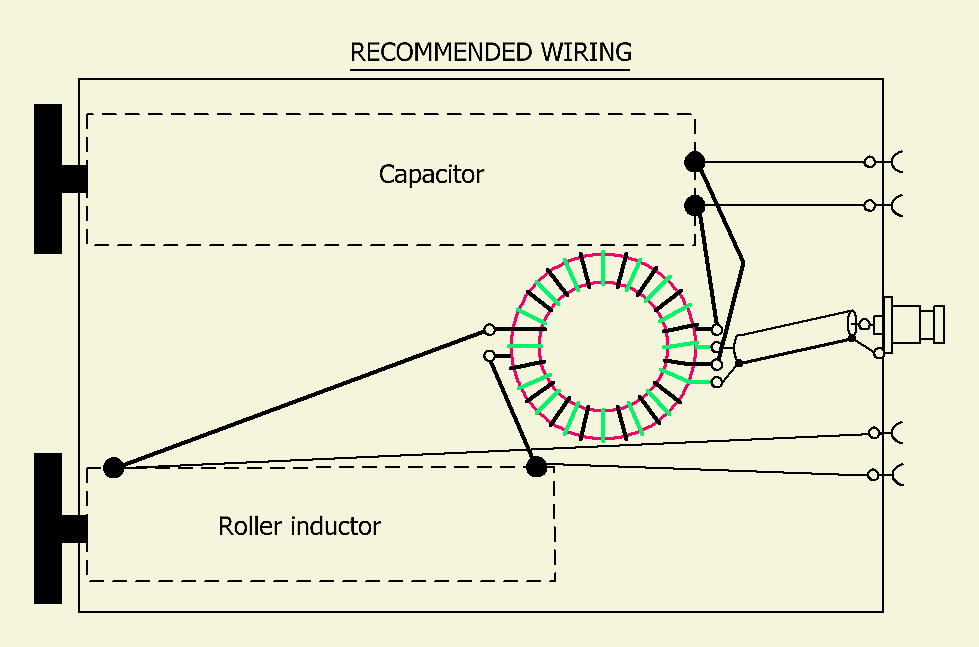
Some hams on Internet sites state that in comparison tests the S-Match failed regarding balance. The authors brought no evidence whether the balance of the "reference" ATU was tested properly….
You may conduct proper tests if your feeder line is in balance with real ground. Use the S-match or any other unbalanced tuner for the test. Connect one of the feeder lines to the ATU (fig. c), match for lowest SWR and measure the RF current. Repeat the test with the other end of the feeder line (fig. d). Check and mark whether both currents are equal or not. As a "ground" you can use a single wire in the backyard or a wire to your central heating system.
The («fig) wiring is also important and it is best to install as showed in the image.
INDUCTORS WITH SWITCHED TAPS

The use of a roller inductor enables tuning only by turning knobs. Some hams don’t like roller coils, not realising that a switched inductance with many taps has a lot more self-capacitance and self-inductance. Most of the time you can’t achieve a proper adjustment because the needed point is somewhere in between the taps. Still, I provide in this present application a switched inductance of 25 µH, which will be adequate for most of the antenna systems. An extra variable capacitor of 470 pF from a vintage AM receiver can be added in series with the input to help reducing the VSWR.
Another method is with a quasi roller inductor.. This is achieved by switching a large variable capacitor in series with the switchable coil. This ensures a fine control of the self-inductance.
|
|
|
REPEAT TESTING
The earlier made notes had been lost and it was decided to repeat the testing of the different designs to determine which one was the best solution. At the same time it was investigated to see if there was even a better solution than those known to-date. A temporary set-up, shown below, was used.
|
At present my favourite systems are fig 2 and fig 5. |
There was hardly any difference in the efficiency of any of the four designs. Afterwards the symmetry became the focus. The settings of the S-Match need to be adjusted for a SWR = 1 between the transmitter and the ATU in order to achieve the best possible balance. When this was done, design figure 2 showed to be the better one for use on the frequencies between 1.8 MHz and 10.150 MHz. Design figure 3 showed to have the best symmetry for the frequencies between 14 MHz and 30 MHz. No sound explanation has been discovered for this difference. Design fig.2 requires slightly more inductance than design fig.3 (which has the antenna parallel to the capacitor). Between 14 MHz and 30 MHz the higher inductance requirement of the roller inductor is advantageous. Please refer to the below mentioned comments of a German HAM on using the S-Match on the 10 meter band.
The capacitor can be a split stator with a grounded stator. If the parts are built in a metal or screened cabinet, they should be assembled on at least 5 cm distance of all metal parts to minimise the asymmetry of the used components.
|
These components were used for the repeated test of the design. |
Test of the figure 5 design. The capacitor is suited for a 400 W ATU but survives a test with 700 W on 80 and 160 m! |
|
|
|
|
|
These small caps are suited for at least a 100 W ATU. |
|
|
Final test |
Finished |
|
|
|
All pictures are just illustrative examples of this S-Match design.
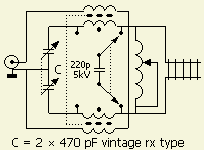
This simple ATU with variable capacitors (from a vintage AM receiver) and a T200-2 toroid is suitable for 400 Watts (fig»). The matching range can be increased with an extra-switched 100–220 pF/5 kV fixed capacitor and used when the antenna impedance is below 50 Ω. With my inverted dipole it was necessary to switch-in the fixed capacitor in parallel with the roller inductor only on the 80 m band.
CONVERSION

A T-match unit can easily be converted to an S-match by removing the second capacitor or bypassing the first capacitor. The free hole in the front panel of a converted commercial unit can be used for a switch for paralleling fixed capacitors to the tuning capacitor to provide additional capacitance.

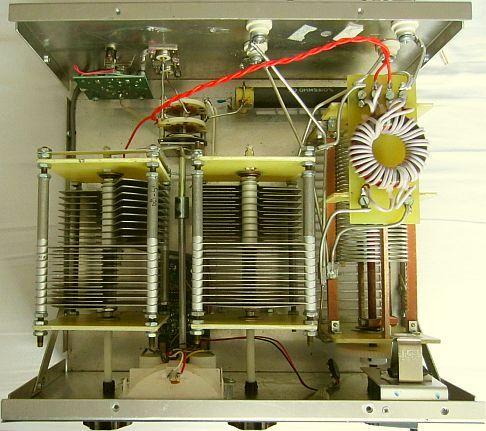
S-Match conversion of a MFJ-989D Versa Tuner V. The modification was successful. See topic.
DJ4ZC MODIFICATIONS
DJ4ZC has made a number of modifications that I have not (yet) tested, but his motivation is plausible.

The RF transformer got an extra compensation winding, making it a trifilar system. The third («blue) winding is identical to the primary winding. However, the "hot" side is not connected to the 50 Ohm input, but connected to earth/ground and is therefore in the opposite phase. The other end is installed floating. Furthermore, the secondary windings are arranged between these two primary windings. With this method, the capacitive coupling of the secondary winding produces equal currents in the primary, but since they are opposite in phase, they cancel each other out. Thus, all "common-mode" noise picked up by the feeder line is largely suppressed for the receiver. On some bands, this measure At his location the noise level was reduced by around 20dB.
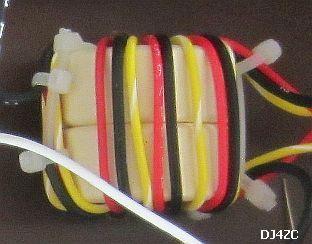 The transformer was made of ferrite material, because ferrite transformers can be smaller, have fewer losses and the stray induction and capacitance are smaller than with powder-iron cores. Using the design information in the Philips Application Note ECO6907 and with measurements taken by W0RUN on 4C65 ferrite, it turned out that a transformer with two stacked T36/23/15 cores of 4C65 mix is suitable for a maximum of 1 kW.
The transformer was made of ferrite material, because ferrite transformers can be smaller, have fewer losses and the stray induction and capacitance are smaller than with powder-iron cores. Using the design information in the Philips Application Note ECO6907 and with measurements taken by W0RUN on 4C65 ferrite, it turned out that a transformer with two stacked T36/23/15 cores of 4C65 mix is suitable for a maximum of 1 kW.
To remove any electrical charges that sometimes occur on the antenna and cause noise problems, 3 × 330 k resistors were added in series. That number was due to the expected high voltage with his too short antenna for the 160 m band.
SOME NOT TESTED IDEAS
|
I was regularly asked whether my system can be applied as an anode circuit for a RF amplifier. It is also possible, but due to lack of time I was not able to test the circuit with high power to fully support the idea. That is a good opportunity for you to try it out. |
 |
PAØLL (†,SK)
As an encouragement for home brewing see in alphabetical and numerical order examples of S-Match tuners. Not everyone is just as skilful but it is most important that it works well.
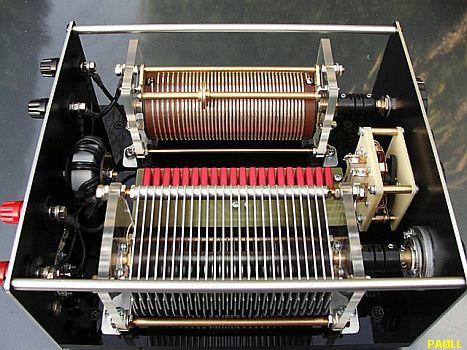
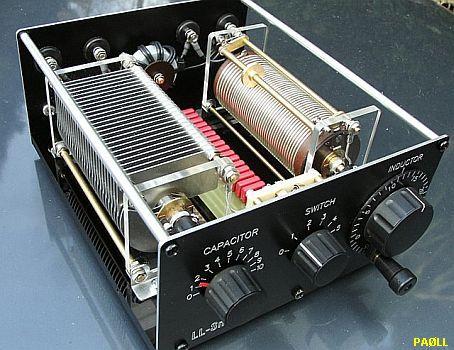
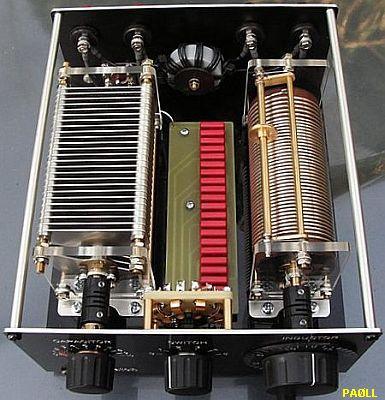
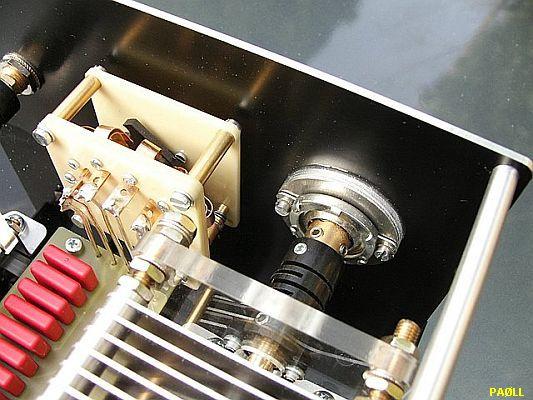
Kees, PAØLL who is famous for his LL-tuners, sent me photographs of his "LL S-Match". There was much demand for a small portable antenna system including a small ATU. For this reason his intention was to build and sell a handy ATU inclusive the antenna in a carry box. The final product is built with components, which are made especially for the tuner. C = 11 - 470 pF (knob with 1 :_6 reduction), L = 34 µH. The ferrite toroid for the balun was specially made by Amidon for this ATU. I expect that all his handcrafts made ATU's ends as "collector items"!
PE1KQP's and PE1ADY's S-MATCH
|
PE1KQP modified his CL tuner to an S-Match. During test on field days it turns out that his ATU outperforms many commercial types. |
PE1ADY's experimental S-Match for his 2 × 20 m dipole and 20 m feeder line. He obtained a SWR = 1 at 1.8 - 29.5 MHz. |
4 × PE2B's S-MATCH
|
|
|
|
|
|
|
|
|
|
|
|
PAØMJM
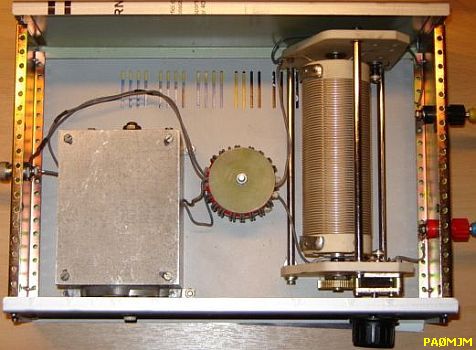
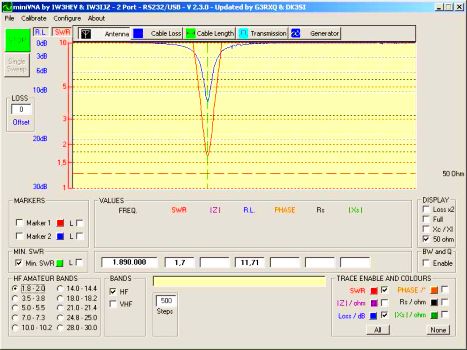
The version of PAØMJM's S-Match. The graphics were made with a miniVNA (www.miniradiosolutions.com) program.
COMMENTARY
Since I published this design, may hams successfully copy this simple ATU.
|
|
PA3EGH's S -Match |
Some of the selected emails are presented:
DJ9XG:
Ich habe wieder einmal etwas von deiner ufb homepage nachgebaut, eine S-Match ATU. Ich habe hier 3 verschiedenen ATU's und diese auch alle 3 getestet.
1. Drake MN2700 mit externem 1:4 Balun
2. Parallelkreis Koppler ähnlich Johnson oder Annecke
3. S-Match nach PA0FRI
Als Antenne verwende ich hier eine 2 × 20 m Dipol symmetrisch mit 240 Ohm Schlauchkabel (Antennenkabel für UHF-Fernsehantennen aus den 70er Jahren) gespeist. Antenne hängt zwischen 15 m und 9 m über Grund.
Mit allen 3 Antennen erreiche ich von 160-10 m 1:1 SWR... die Ergebnisse vieler Tests sind folgende Reihenfolge:
1. S-Match auf allen Bändern Nummer 1
2. Parallkreis nach Annecke Nummer 2
3. Drake Tuner Nummer 3
Du siehst dein S-Match ist der beste ATU, hinzu kommt noch die komfortable Bedienung. Ich habe den hier mit einer riesigen kommerziellen Rollspule 14 µH und einem 20-200 pF Sendedrehko aufgebaut. Als Ringkern verwende ich im Moment noch 1 Amidon T200-2, werde den aber gegen eine 2 Ringkernlösung mit 2 x T200-2 ersetzen, da der eine Kern bei 1 kW Output doch etwas warm wird.
Nun zu meinen Beobachtungen mit der S-Match. Bei 160 m benötige ich nur ca 7 µH der Rollspule und ca 400 pF für den Drehkondensator (ich hatte eigentlich damit gerechnet dass die Rollspule zu wenig Induktivität auf 160 m hat). Bei den höheren Bändern wird das L natürlich noch kleiner (auf 10 m habe ich noch 1 Windung der Rollspule). Trotz dieser sehr kleinen Werte ist die S-Match immer noch die beste auf allen (!) KW-Bändern.
DC1DV:
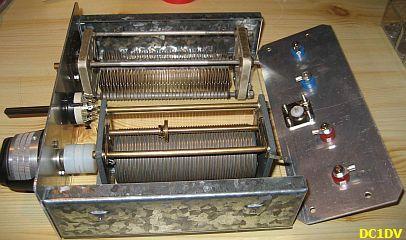
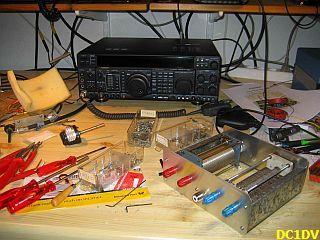
Zunächst einmal möchte ich mich ganz herzlich für Ihre Veröffentlichung zum S-Match im Internet bedanken. Der S-Match Koppler hat sich zum effizientesten Bastelprojekt seit langem bei mir heraus gestellt. Warum? Nachdem sich mittlerweile bei mir die verschiedenen Koppler, ähnlich wie bei Ihnen stapeln, sollte man meinen es sei endlich genug. Nichts dergleichen!
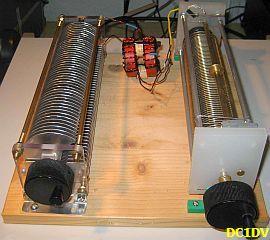
Bei einem Test, neulich mit Peter, DC0DX, auf dem 160m Band, hatte ich mehr aus Spaß meinen S-Match Probeaufbau (fig») angeschlossen, den ich schon für ein anderes Projekt auseinander reißen wollte. Donnerwetter, das Rauschen war von fast S7 auf um S2 gesunken, aber Peters Feldstärke blieb mit um die S9 erhalten. Ich traute meinen Augen kaum. Darüber hinaus bekam ich vom Peter noch einen deutlichen Lautstärkezuwachs bescheinigt. Dieser ließ sich leider nicht näher spezifizieren („Mit Brille wär´ das nicht passiert…") Schnell also den Antennen-Umschalter her und dann verglichen. Kein Koppler brachte so tolle Werte.
So sehr ich mich über den Erfolg freute, um so weniger konnte ich mir auf das so extrem positive Verhalten einen Vers machen. Leider bis heute nicht. Nun stellte ich mir allerdings die Frage, ob der S-Mach Koppler nur an meiner V-Antenne (2 × 15 m, ca. 40° Öffnungswinkel) so ein gutes Verhalten zeigte. Nirgendwo hatte ich von solchen schier unglaublich tollen Werten gehört oder gelesen. Also ab in Dieters Garten (DB3DK) und den neuen dicken HP Vergleichskoppler und den S-Match aufgebaut. 2 × 20 m Antenne. Welche Überraschung: Beide lagen im Empfang absolut gleich!
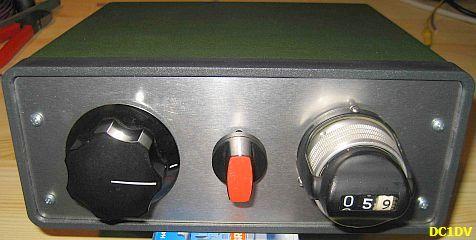


Abgesehen von der Wirkung an meiner Antenne, zeichnet sich der Koppler durch seine absolute Einfachheit aus. Der jetzt von mir aufgebaute kleine Koppler (fig») beinhaltet neben dem Ringkern einen Drehko (439 pF) von lediglich 1.5 mm Plattenabstand und eine relativ kleine Rollspule (28 µH) a la Annecke. Im abgestimmten Zustand sind 100 W HF absolut kein Problem. Die zusätzlich schaltbaren Kondensatoren werden an einer 2 × 20 m langen Antenne nicht benötigt, bei mir zuhause allerdings doch. Im 80 m Band brauche ich 1100 pF, wenig L und auf 160 m reicht der Drehko neben 21 µH der Rollspule. Es funktionieren übrigens alle Bänder von 160 bis 10 m einwandfrei.
Bleibt noch zu erwähnen, das manchmal die Antenne an den Drehko gelegte werden muss und manchmal an die Rollspule. Meist ist der Ausgang an der Rollspule zu nutzen.
Das Abstimmverhalten ist am Drehko spitz wie eine Nadel und an der Rollspule butterweich. Also bewege ich zunächst den Drehko in die richtige Richtung und dippe dann mit der Rollspule nach. Das Finden der ersten Resonanz ist allerdings leicht schwieriger als beim HP Koppler, aber dennoch gut zu meistern.
DL1FDL
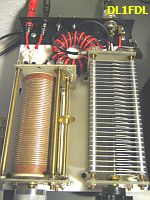
Your design is very interesting, because it is very easy to build (e.g. for HF beginners), saving expensive radio parts and it is small in dimensions (e.g. for portable ham activities). In my case I have used a 34 µH/3 A coil, a 220 pF/2 kV capacitor and a toroid T200-2, enough for more than 100 W power. I am using your S-March concept (fig») now together with my 2 × 12.5m portable dipole and a 13 m feeder line in the field. It's coupling the antenna in good balance from 80 m to 10 m band in a perfect SWR. It fits perfect the little size of my TS 50.
DL4YEH

Hier mal ein Bild von meiner SMatch ein Super Sym.Koppler, klappt an meinem Dipol mit Hühnerleiter wunderbar. Im vergleich zu Annecke oder MFJ 974HB besser zu bedienen RX/TX seitig kein Unterschied festzustellen.
DL5GBL:
Ich habe eben provisorisch Ihren S-Match mit alten Teilen aus der Bastelkiste auf Brett zusammengeloppt und getestet. Bauzeit: Gerademal eine halbe Stunde (inklusive dem Wickeln der 2 Trafos (T184: 2 × 8 Windungen 1.5 Schaltdraht für 3µH).
Fazit: Alles problemlos!!!- Ich bin restlos begeistert und werde mir ein paar reguläre Geräte davon
bauen.
DC4JG:
|
DC4JG's S-Match built with a T225A-2 toroid and a variometer. |
Ich habe auf deiner Internetseite die Beschreibung zum S-Match-Koppler gelesen und den Koppler sofort nachgebaut. Der Drehko ist ein Schmetterlings-Drehko 20 bis 200 pf und das L ist ein Kugelvariometer mit 8 bis 45 µH. Der Übertrager ist ein T225A-2. Der S-Match funktioniert prima. Ich habe viele Koppler probiert siehe www.dc4jg.de aber keiner ging so unproblematisch wie der S-Match. Ich überstreiche mit dem kleinen Drehko und dem Kugelvariometer alle Bänder 160 bis 20 m, der Rest ist nicht probiert. Aber alles in allem, ein guter Koppler. Der Koppler ist auch an der Feederleitung sehr gut symetrisch. Hier haben schon 3 bis 4 OM´s diesen Koppler mit Erfolg gebaut.
DO2KH

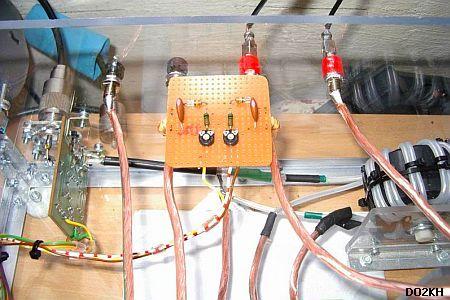
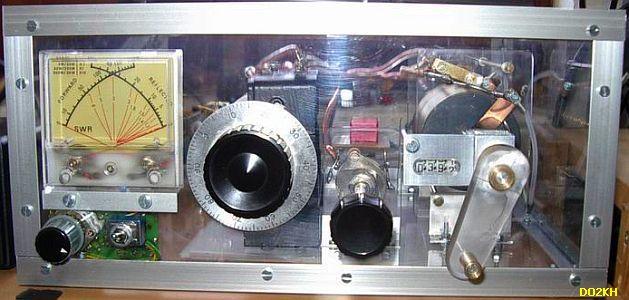
Auch dies wäre eine Variante die man nicht ausser acht lassen sollte. Betreibe seit mehr als einen Monat diesen symmetrischen Koppler. Mitlerweile habe ich den Testaufbau ordentlich in ein Plexiglasgehäuse eingebaut. Ich fügte einen SWR/ Power Messkopf im Eingang hinzu, sowie Ausgangsseitig einen Messkopf um die Spannung am Übergang zur H-Leiter Messen zu können. Er passt von 160-10 m an. Da ich wissen wollte, ob es einen grossen Unterschied zwischen einem symmetrischen Koppler, Schaltung Palstar, oder nach PA0FRI gibt, baute ich mit zwei Russenspulen und einem Drehko diesen nach, Ergebnis; meine Gegenstationen konnten keinen Unterschied Feststellen. (Test: wie immer über mehrere Tage, 160, 80, 15 und 10 m, 2 × 15.60 m (ehemalige G5RV) und 26 m H-Leiter da ich bis zum Shack kommen müsste).
Den leicht und kostengünstige herzustellenden symmetrische Koppler nach PA0FRI kann ich empfehlen, ich konnte keine Unsymmetrie, Phasenverschiebung messen. (Messender, Koppler, jeweils verschiedene Abschluss R´s der anzunehmenden impedanz an der H-Leiter und zwei identische Tastköpfe an ein HP Oszi) Beide Koppler verhielten sich nahezu gleich.
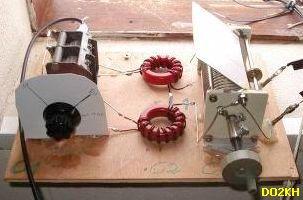
Der Vorteil beim S-Match ist die Grösse und der geringe Kostenfaktor der Bauteile, man kann ihn auf kleinsten Raum aufbauen, eine Rollspule ist nicht unbedingt erforderlich, Spule mit Anzapfungen und einem min. 12 Stufigen Schalter reicht auch.
Wie o. g. reicht ein einfacher Doppeldrehko mit 2 × 500 pF. Für 160 m sollten dem Drehko min. 100-330 pF paralell hinzugeschaltet werden. Ein Aufbau mit zwei T200 Kerne («fig) ist auch nicht erforderlich, ich konnte keinen Unterschied messen bei der Variante mit einem Kern, wiederum ein Bauteil weniger.
DO7DE
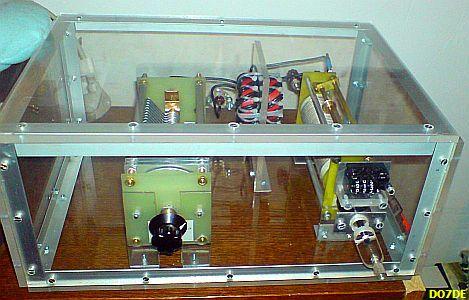
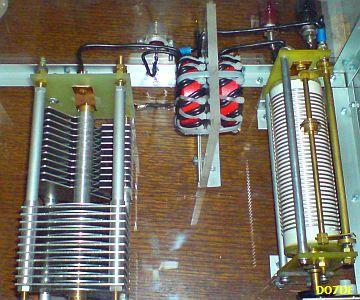
Ich habe mir auch denn S-Match mit einem Split-Drehko 2 × 220/1.5 kV, einer RollSpule 15.5µH (1.5 Silberdraht), sowie 2 × T200-2 Rinkerne nachgebaut. Der S-Match macht seine Arbeit von 10 m bis 160 m hervorragend an einem Symetrischen Dipol! Werde dem S-Mach aber noch ein Kreuzzeiger-Stehwellen-Messgerät hinzufügen in das Gehäuse. Ich bin super begeistert und kann ihn nur weiter Empfehlen.
NL2LK
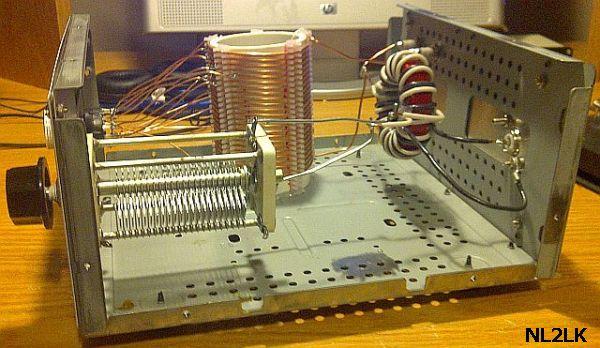
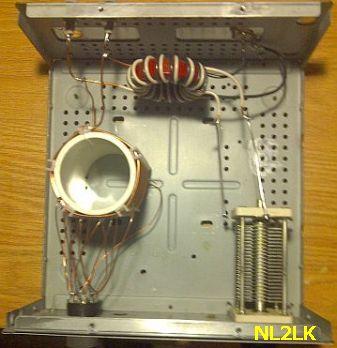
ZL2ML
ZL2ML emailed the following:
Initially I had a LDG automatic tuner but at times it just did not match properly. I next build a balanced tuner with two roller inductors according to the information provided by AG6K in his publication 'A balanced antenna tuner'. This worked a lot better. But manually turning two mechanically coupled roller inductors is not very light and the design is only a L-C which means that any impedance's that fall between approx. 37.5 and 75 Ohm need large values of either the capacitor or the inductor and hence normally do not get matched properly. (This is also the reason why many automatic ATU's like the LDG do not tune below a SWR of 1 : 1.5 )
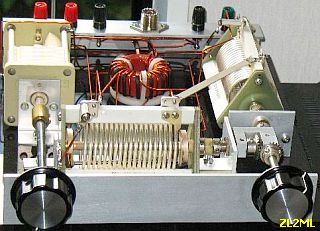
It was a simple matter to test the S-match out (fig») and then I proceeded to build it properly. Am using a Johnson 229-203 roller inductor 20 µH/5 A, a Jackson Brother 2 × 300 pF/1 kV variable capacitor and on 80 meters I add two 180 pF/2 kV Vitramon capacitors in parallel to obtain a match.
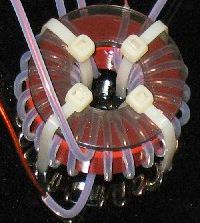
The toroid is a T184-2 («fig) and it was chosen because it needs less winding to obtain the 3 uH inductance than the other toroids. That means less parasitic capacitance. The windings are #16 gauge Thermaleze (2 kV isolation) with Teflon tubing. Primary is 11 windings (exactly 3 µH) and the secondary is 2 × 5 windings (fits evenly between the primary windings: if the primary was 10 windings then 1 secondary winding would not be 'nested' between two windings of the primary). As 'base' I used 10 mm Plexiglas. But do not use black Plexiglas (like I did): it shows every speck of dust in a photograph! The cover is made of solid walnut, which just rests on the Plexiglas and is held in place by the groove that sits over the edge of the front panel. In this way it is easily removed for once a year cleaning and re-lubrication (very sparingly with the proper conductive lubricant) of the roller inductor wheel.
|
|
|
|
|
|
Many thanks to PAØFRI for coming up with this design and I have now disposed of all the other antenna tuners, this one is a keeper.
AIR WOUND BALUN
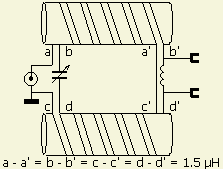
An OM asked me if he could use a balun without any core. During my early experiments, I did a brief test on this subject but I lost the notes in my rough-copy book. I still remember the two formers -1" in diameter which were close wound with bifilar turns of well-insulated wire. Each coil was of 1.5 µH inductance. Than, to save space and avoid any external field's influence, I continued the experiments with toroid baluns.
![]()